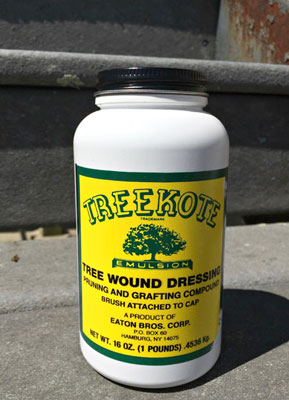 |
| Thinking of using grafting wax or compounds on organic fruit trees? Know the NOP rules and, if in doubt, check with your certifier first. English photo |
By C.J. Walke
Over the winter I have been talking with MOFGA Certification Services (MCS) about materials used in organic orchards and fruit tree propagation. As more farmers and orchardists as well as backyard growers engage in fruit tree propagation through grafting young stock and topworking existing trees or wild, seedling stock, we’ve had to look more closely at commonly used grafting waxes and compounds and their compliance with the National Organic Program (NOP).
The grafting process essentially joins two pieces of wood together through various grafting techniques to create a new tree or limb, but most methods require exposure of internal wood to the air and elements. We commonly use grafting wax or compounds, such as Treekote or Trowbridge’s Grafting Wax, to seal these exposed wounds and protect plant tissue from drying while they heal, as well as to prevent disease from entering the wound. The issue is that neither product has been approved for use on organic farms.
However, grafting wax as a generic material is approved with restrictions by OMRI (Organic Materials Review Institute) as a crop tool or production aid and can be used on perennial, nonorganic stock that will be managed organically for 12 months before organic harvest. NOP rule 205.204(a)(4) reads, “Nonorganically produced planting stock to be used to produce a perennial crop may be sold, labeled, or represented as organically produced only after the planting stock has been maintained under a system of organic management for a period of no less than 1 year.”
How does this work out in the field? When bench grafting new stock and using grafting compounds, that new stock, once planted out, must be grown within an organic system for 12 months before being labeled or sold as organic. This is relatively easy to comply with because these young trees are usually in a nursery bed for two or three seasons to grow and gain size before being dug and sold as young organic fruit trees or transplanted into the organic production field.
When we get into topworking existing trees that are within a certified organic system and are grown in organic soil, the details become a bit more particular. If you plan to topwork a limb on an established tree that is certified organic and use a grafting compound to seal the wound as well as the tips of the scions, that new limb is now considered not organic for the next 12 months, per NOP rule 205.204(a)(4) mentioned above. This is also easy to comply with because it will take a few years for that new limb to grow and produce a crop. However, the rest of that tree maintains its organic status, and the harvested crop can continue to be marketed and sold as certified organic. Good records must be kept of which limbs have been grafted.
If you decide to topwork an entire tree over to a new variety, the tree would lose its organic status until the 12-month period of management in an organic system is established. Considering these changes to the trees, these topworked trees must be well labeled and documented in your Organic System Plan (OSP), and MCS would like you to include in your annual update the materials, crop and location of the grafted trees.
Most importantly, grafting compounds can be used only as a sealant during grafting and the propagation process and must not be used for any other purpose in the tree, such as sealing a pruning cut or other wound. Any use of a grafting compound other than as a grafting sealant for propagation purposes will result in decertification of the affected tree or trees for 36 months.
Another orchard practice that is commonly misrepresented as approved for organic production is the use of latex paint on the trunks of trees, either to prevent sunscald or southwest injury, or to help make damage from round-headed apple borer larvae more visible, as the orange/brown frass stands out against the white background of the painted trunk. Latex paint contains synthetic polymers (acrylic or vinyl acrylic) that act as binders in the paint, and neither is allowed under NOP rule 205.601, Synthetic substances allowed for use in organic crop production.
As for other products to meet this same end, I do not know of an approved product that can be used to cover the base of a tree trunk, similar to the paint method. I have been asked about lime washes and milk paints, but those products often contain ingredients not allowed in organic crop production, or the production company may not want to disclose the full list of ingredients, protecting proprietary information. This makes it extremely difficult to approve the use of such products.
The bottom line: Always communicate with MOFGA Certification Services or your accredited certifying agency about using any product in crop production or processing that is not clearly labeled as approved by OMRI or that is not on a known list of materials approved by your organic certifier.
C.J. Walke is MOFGA’s orchard educator. You can contact him at [email protected].
